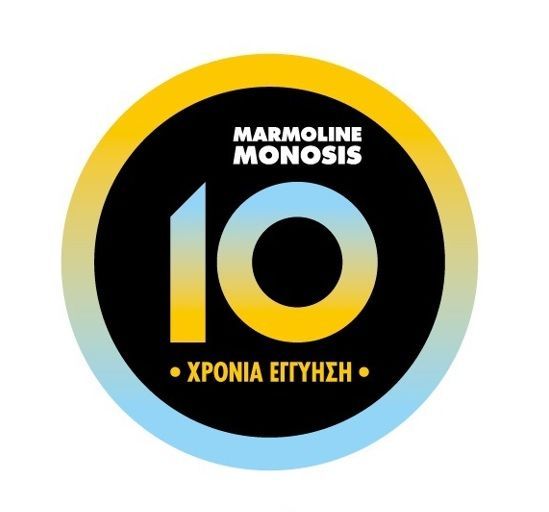- December 21, 2020
MARMOLINE MONOSIS
MARMOLINE MONOSIS is a complete, certified system of external thermal insulation of buildings (old and new), adapted to the very special Greek climatic conditions, due to which in many areas of the country we have strong cold in winter and a lot of heat in summer. In many parts of Greece, the annual temperature fluctuation (min – max) on the outer surface of the wall can exceed 60 ° C, thus requiring special building materials that can withstand this temperature range.

MARMOLINE MONOSIS comes with a 10 year quality guarantee :
For terms and conditions, please contact the commercial department of the company.
Uses
- Old buildings: Non-thermal insulated buildings, resulting in high costs of heating and cooling costs.
- New buildings: Buildings in which, although some insulation of the skeleton and walls have been provided, this insulation does not work successfully, resulting in significant losses and water vapor liquefaction on the interior wall surface.
External insulation systems have been used in Europe for at least 50 years. As stated by the UAE (European Union for external thermal insulation systems) on its website http://www.ea-etics.eu/, in recent research results it has been concluded that systems that have been in place for 30 years have not shown any problems to date. The durability of external thermal insulation systems seems to be much greater than initially expected. If carefully applied and properly maintained, their expected life span corresponds to a brick masonry plastered with common plaster. In addition, because the exterior plaster of an external thermal insulation system is separated from the masonry through the insulating plate, the risk of cracks / breaks is even lower.
ETICS = EXTERNAL THERMAL INSULATION COMPOSITE SYSTEMS = External Thermal Insulation Systems
Advantages
- It provides excellent thermal comfort inside the building.
- Ordinary bridges are not created in beams, columns, drains and floors, where the masonry meets these elements, even if they are insulated, thereby eliminating the possibility of water vapor and mold.
- It protects the wall surfaces from moisture, as waterproof coatings are used. This offers conservative protection to the building, while reducing the need for heating and cooling.
- It contributes to the energy economy, since no heat-resistant surfaces are created on the outside of the walls, so that the heat-absorbing walls can only be used to heat the interior of the building.
- In a new residence, the area of the operating space is increased by approximately 6 square meters to every one hundred square meters of living space.
- It dramatically increases the life of the building as it protects it from corrosion and frost.
- The MARMOLINE MONOSIS system has no cracks.
- The application of the system creates less hassle than the application of conventional coatings, as the coatings used are spatulas, since they are highly thixotropic. As a result, the work leaves no rubble beyond the residue of the heat-insulating material used.
- The construction quality of the system is very high, as specially tested angles, sprinklers and certified glass mesh are used to reinforce the coating across the application surface.
- The building is highly rated for its energy efficiency.
- Such a system has an average depreciation time of 4 to 6 years, from energy savings alone.
- Energy saving (from 35% to 65% compared to using heating oil).
- Excellent, hygienic, quality thermal environment inside the buildings.
- Easy to apply to both new and old buildings.
- Ideal for renovating old buildings.
- High quality output in all types of buildings (detached houses – apartment buildings – industrial buildings).
- The sound insulation of buildings is improved
- Economy by reducing construction costs.
- Better static of interior walls (single wall with wide brick or brick).
- Reduce the load on the building.
- High speed of construction.
- Simple application.
- Cleanliness during construction.
How to Apply
- Prepare and inspect the masonry and concrete. Install the angle of initial support of the insulating plates.
- Apply the MARMOLINE FK 201 adhesive with the help of an automatic press provided by MARMOLINE, or by hand, around the surface of the insulation plate, approximately 5 cm wide. Apply at least 3 stamps inside. This will smooth out the unevenness of the substrate and ensure that it is smoothed by contacting at least 40% of the surface of the plate with the substrate.
- Horizontal and vertical mounting of scales by the craftsman facilitates smooth and rapid continuation of work.
- Install the insulating plates by pressing from base to top and pressing them together. It is important for the plates to cross each other by 40% – 50%. If there are gaps between the plates then they should be filled with special polyurethane foam. Additional support is recommended with the MARMOLINE plastic special plugs, after the adhesive hardens (6 pieces / m²).
- Place an appropriate reinforcing glass mesh weighing 160 gr / m². The application is done after applying a first coat of MARMOLINE FK 202 adhesive-coating over the entire surface of the plate. Then press the sheet-by-layer on the wet glue, making sure that there is a 10 cm overlap without creasing. Then apply a second coat of FK 202 to fully cover the fiberglass.
- The corners of the openings (doors – windows) must be reinforced with the special plastic mesh angles provided by MARMOLINE, while placing the glass mesh on the plates. The corners of the windows and doors should be fitted with a diagonal grid for additional reinforcement. Where necessary, the application of special elements water sprinklers is applied on horizontal edges.
- Apply MST 11 acrylic primer.
- Apply the MARMOLINE SVR acrylic fluid resin colored plaster after at least 15 days after application of the glue-glass-glue system. Apply the plaster evenly across the surface with a flat spatula. Adjust the end surface with a suitable scrub or spatula, depending on the desired effect. Surfaces must be completed so as to avoid discontinuities.
Alternatively, the FK 202 ORGANIC paste can be used instead of the cementitious, FK 202-coated adhesive.
Also, instead of the resin paste SVR acrylic coating, the SVR SILICONE silicone coating can be used.
Specifications
The MARMOLINE MONOSIS ENERGY SAVING SYSTEMS ETICS system has received Technical Assessments (EDFs) from the large Czech TZUS (Technical and Test Institute for Construction – Prague http://www.tzus.cz/en/) member of EOTA (European Organization for Technical Assessment), according to the European Directive ETAG 004 (Guideline for External Thermal Insulation Composite Systems with rendering):
ETA 17/0100, for expanded polystyrene EPS insulation system
EFF 14/0214, for an extruded polystyrene XPS insulation system
ETA 14/0213, for MW insulation plate system, wool
Using cementitious adhesives (FK 201 – FK 202) and EPS – XPS insulating plates, the System reacts to fire B-s1, d0 while with MW plates reacts to fire A2-s1, d0 (according to EN 13503-1)
Under the requirements of the CE marking of the System, the company is periodically and systematically audited by the notified and independent body TUV HELLAS, which confirms and certifies the performance of the MARMOLINE MONOSIS system (Certification No. 0654-CPR- 0133).
MARMOLINE recommends the implementation of the MARMOLINE MONOSIS ENERGY SAVING SYSTEMS ETICS system only with the individual components (insulating plates, grids, nails) which it proposes in the Performance Statement accompanying the System. Otherwise the company bears no responsibility for problems with poor performance or material compatibility.
Means of disposal
Summary of the individual components of the system:
Thermal insulation welding adhesive, MARMOLINE FK 201:
Consumption: Covering 1 m² requires approximately 4 – 7 kg of mortar, depending on the method of application and the type of substrate.
- Grey colour
- Concrete adhesion force: > 0.25 MPa.
- Insulation adhesion force: >0.08 MPa
- Compressive strength: 20.0 MPa.
- Bending strength: 5.0 MPa.
Thermal insulation plates:
- Expanded polystyrene (EPS) plates up to 100mm thick, plain and graphite.
- Extruded polystyrene (XPS) plates 40 – 300mm thick.
- Rock wool slabs (MW) 50 – 200 mm thick.
MARMOLINE company for the implementation of MARMOLINE MONOSIS ENERGY SAVING SYSTEMS ETICS has thermal insulation plates of the appropriate specifications
In the attached table , you can see the thermal conductivity “λ” of the MARMOLINE EPS & XPS plates.
Storage: In a dry place without moisture, and protected from the sun.
Plastic nails (pins), for supporting the insulating plates:
Plastic nails (pins), of the appropriate specifications according to the ETAG 014 Directive, with the necessary certifications. The nails can be entirely plastic or with plastic head and metal nail.
Consumption: at least 6 – 8 nails / m².
MARMOLINE FK 202 Fiber Coated :
Consumption: 4 – 4,5 kg dry mortar per m², reinforced with fiberglass, on polystyrene or stone wool
- Color: White
- Insulation adhesion force: >0.08 MPa (for EPS, XPS), and> 0.01 MPa (for MW – insulation breakage)
- Compressive strength: 20.0 MPa.
- Bending strength: 6.0 MPa.
MARMOLINE FK 202 Organic paste- coated :
Consumption: About 3 kg / m², reinforced with fiberglass, on polystyrene or stone wool
- Color: White
- Insulation adhesion force: >0.08 MPa (for EPS, XPS), and> 0.008 MPa (for MW – insulation breakage)
- Density: 1650-1850 kg / m³
Fiber glass mesh for insulation materials:
Special glass based on the requirements of the ETAG 004 alkali-resistant, about 160 gr / m gr and about 4×4 mm cannabis, for use in combination with MARMOLINE FK 202 or FK 202 Organic.
All of the suggested fiberglass mills are of the appropriate specifications and by companies with the necessary certifications
MARMOLINE MST 11 Primer :
Special acrylic water primer, consuming approximately 1 kg per 10 m²
MARMOLINE SVR , resin paste colored coating:
- Granulometry: SVR 1 mm, SVR 1.5 mm, SVR 2 mm, SVR 3 mm.
- Fire resistance: A2-s2, d0 (EN 13501-1)
- Specific gravity of fresh mortar: SVR 1 mm: 1700 – 2000 Kg / m³, SVR 1.5 mm: 1850 – 2150 Kg / m³, SVR 2 mm: 2100 – 2500 Kg / m³, SVR 3 mm: 2300 – 2900 Kg / m³.
- Consumption: SVR 1 mm (1.8 – 2.0 kg / m²), SVR 1.5 mm (2.0 – 2.3 kg / m²), SVR 2 mm (2.5 – 3.0 kg / m²) ), SVR 3 mm (3.0 – 3.5 kg / m²)
MARMOLINE SVR Silicone , silicone paste colored coating:
- Granulometry: 1.5 mm
- Fire resistance: A2-s2, d0 (EN 13501-1)
- Specific weight of fresh mortar: 1850 – 2150 kg / m³.
- Consumption: 2.0 – 2.3 kg / m²





